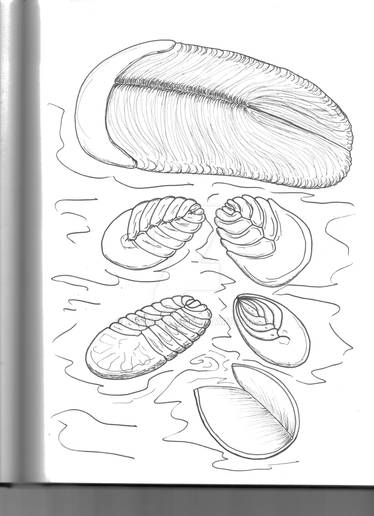ShopDreamUp AI ArtDreamUp
Deviation Actions
Description
This will be moved to scraps soon, so I didn't put as much effort into cleaning up the rough bits of the scan.
Just some studies of plants in the superdivision Trichophyta.
A brief overview of trichophytes: these true plants comprise the majority of Erytheia's autotrophic plant life, with the other major true plant group being the Lepidophytes, commonly called Ladon plants. Trichophytes are named for their photosynthetic organs; cuticle bound tubules filled with photosynthetic cells and transport tissues. These tubules are the equivalent to leaves in Earth plants, and give trichophytes a hairy or fuzzy look.
Trichophytes are actually colonies, with specialized individuals called phytids becoming specialized for different tasks and forming a collective organism. Often, the more derived a trichophyte is, the more phytids are present in its adult form.
More derived trichophytes have a complex transport system, where a specialized phytid has contractile abilities, and acts as a pump to transport water, sugars and nutrients throughout the colony.
The trouble with plants is that they are so diverse, it is hard to know where to start in presenting them. They are practically like another set of animals. It's difficult to know what single group to pick for explanation. Better to throw a whole bunch out and then go from there.
Just some studies of plants in the superdivision Trichophyta.
A brief overview of trichophytes: these true plants comprise the majority of Erytheia's autotrophic plant life, with the other major true plant group being the Lepidophytes, commonly called Ladon plants. Trichophytes are named for their photosynthetic organs; cuticle bound tubules filled with photosynthetic cells and transport tissues. These tubules are the equivalent to leaves in Earth plants, and give trichophytes a hairy or fuzzy look.
Trichophytes are actually colonies, with specialized individuals called phytids becoming specialized for different tasks and forming a collective organism. Often, the more derived a trichophyte is, the more phytids are present in its adult form.
More derived trichophytes have a complex transport system, where a specialized phytid has contractile abilities, and acts as a pump to transport water, sugars and nutrients throughout the colony.
The trouble with plants is that they are so diverse, it is hard to know where to start in presenting them. They are practically like another set of animals. It's difficult to know what single group to pick for explanation. Better to throw a whole bunch out and then go from there.
Image size
2550x3510px 1.22 MB
© 2011 - 2024 Onironus
Comments4
Join the community to add your comment. Already a deviant? Log In
Thank you very much! Plants deserve an equal amount of attention as animals, especially since they are so crucial to the presence of life.
The plant on the bottom left is in a group of more derived plants that include all air-bladder plants. Their pattern of phytid growth is asymmetrical, and starts on one side rather then in a pair growing outward. The ammonia-filled bulbs are the bladders of successively older phytids, which, in this particular kind of air-bladder plant, do not grow any larger once they have budded a new phytid. The phytids grow a little larger each generation before budding. Just before reaching a detrimental size due to the wind, the phytid above it will repeat the cycle, growing only a small amount until it buds, and so on.
The plant on the bottom left is in a group of more derived plants that include all air-bladder plants. Their pattern of phytid growth is asymmetrical, and starts on one side rather then in a pair growing outward. The ammonia-filled bulbs are the bladders of successively older phytids, which, in this particular kind of air-bladder plant, do not grow any larger once they have budded a new phytid. The phytids grow a little larger each generation before budding. Just before reaching a detrimental size due to the wind, the phytid above it will repeat the cycle, growing only a small amount until it buds, and so on.




































